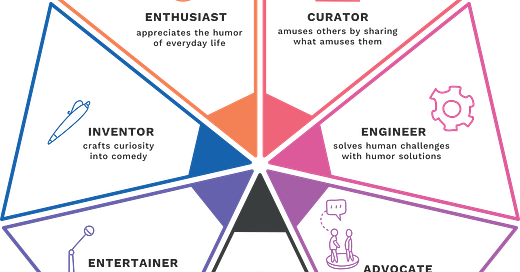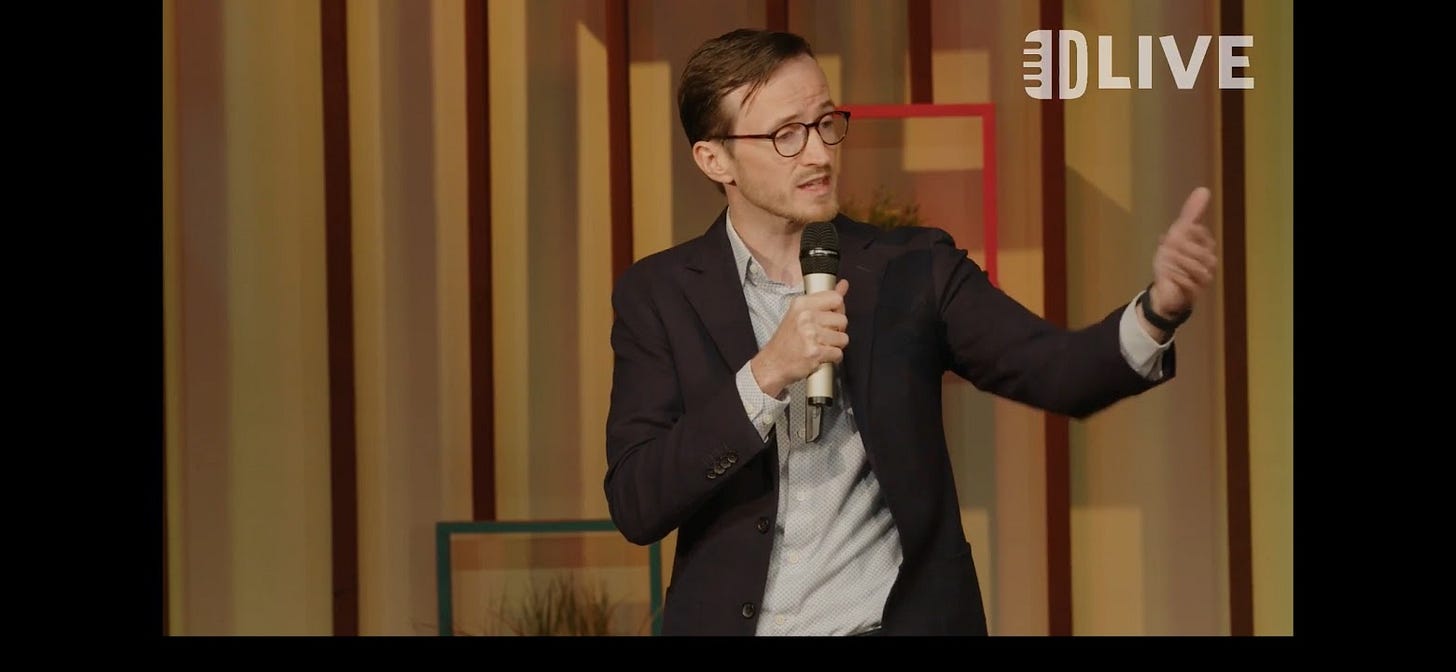Recently, I’ve been doing a lot of 1-on-1 coaching on presentation skills, mostly with really smart people who’ve realized their inability to effectively present is quietly holding back their careers. (More on that in a future post.)
As part of that process, I have everyone complete an assessment on their humor skill.
Last week, one of my clients, Stacey, was blown away by the results. Not because they were particularly good (she scored pretty low on Creation and Performance), but because there were options.
“You don’t understand. I’m ecstatic because I always thought there was just one way to be funny—and I didn’t have it. But it turns out, I do have strengths. Just... not the ones I expected.”
In her case, her strengths were in Curation and Promotion.
This realization—that there’s more than one way to use humor—has been mind-blowing for a lot of people. And I get it.
For most of my life, I didn’t consider myself funny. Heck, even after my TEDx talk went viral and I recorded a Dry Bar Comedy Special, there are still people who don’t think I’m funny. (Some of them are related to me.)
But here’s the truth Stacey just discovered: You don’t have to be remotely funny to effectively use humor.
You don’t have to write the joke, deliver the punchline, or even own a pun-themed coffee mug (though, highly recommended).
Because humor isn’t about being the next Tina Fey, Hasan Minhaj, or that one coworker who responds to every group email with a meme before 9am.
It’s about intention. Perspective. A bit of playfulness. As I shared last week, it’s about asking, “How can I make this more fun?”
That’s why understanding your Humor Persona is so valuable.
Yes, humor is a skill—which means it can be learned. And yes, you can absolutely build all 7 personas over time.
But for those of us who’ve spent decades thinking, “I’m just not funny,” the good news is: You don’t even have to be.
Like Stacey, you just have to discover what kind of humor you’re good at—and start there.
So… How Do You Be Funny Without Being Funny?
There are three incredibly powerful (and delightfully low-pressure) Humor Personas you can embrace:
1. The Enthusiast
Appreciates the humor of everyday life.
You don’t need a joke book—you just need a curious eye and a willingness to laugh. Enthusiasts find joy in the little things: a dog in a raincoat, a pun on a billboard, or the absurdity of having three different apps for work chat.
Being an Enthusiast is all about finding levity in life’s chaos and inviting others to laugh with you—not at a crafted punchline, but at the simple fact that life is weird and delightful and messy.
How to use it:
Find more excuses to smile, particularly at the people you pass by.
Laugh out loud (appropriately) when something tickles your funny bone—it’s contagious in a good way.
Intentionally seek out comedy to help you relieve stress after a long day.
The Enthusiast’s secret weapon is appreciation. They don’t force the funny—they recognize it and revel in it.
2. The Curator
Amuses others by sharing what amuses them.
You don’t have to be the source of the humor to be the reason people smile. Curators are the DJs of delight, spinning up memes, stories, and quotes that make others laugh, think, or feel.
To be a curator, you don’t need a PhD in Punchlines—you just need a good “save” folder and a little courage to share what brings you joy.
How to use it:
End your emails with a light-hearted PS (e.g., “PS: Today I learned that otters hold hands when they sleep. You’re welcome.”)
Share a weekly “Friday Fun” Slack post with the best meme, pun, or feel-good story you found.
Include a funny (but relevant) gif in a deck to make a key point land memorably.
Curation is about connection. The best Curators share with intention—not just for laughs, but for resonance.
3. The Advocate
Creates space for others to shine with humor.
Advocates might not be the ones cracking jokes—but they’re the reason others feel comfortable doing so. They model that humor is welcome. They say “yes” to levity, and that “yes” ripples across teams, meetings, and even entire orgs.
Being an Advocate means creating space for humor—not by being the source, but by spotlighting others and encouraging them to join in.
How to use it:
Start meetings with a fun icebreaker (“What’s your go-to karaoke song?”)
Encourage teammates to share their stories—even if they’re goofy.
Bring humor into culture: celebrate “Pun Day Monday,” post funny signage in the breakroom, or recognize someone for “Best Zoom Background of the Week.”
Advocates don’t need to be the center of attention. They create conditions where everyone else gets to shine.
TL;DR – Be Funny (Without Being Funny)
You don’t have to be “the funny one” to bring humor into your life or your work.
You just have to find the type of humor that fits you—whether it’s appreciating it (Enthusiast), sharing it (Curator), or encouraging it in others (Advocate).
Because the goal isn’t to be a stand-up comic. It’s to be more effective, more human, and a whole lot more fun to work with.
And let’s be honest—in a world of endless meetings, awkward email sign-offs, and Excel files labeled “FINAL_v3_ACTUAL_THIS_TIME,” a little humor goes a long way.
Want to dive deeper into your skill of humor?
Join us for the Skill of Humor Workshop on Wednesday, April 16th as part of International Humor Month! 🎉
This engaging, enlightening, and entertaining session will show you that humor isn’t about being a natural—it’s about being intentional. You’ll learn:
The 7 Humor Personas and how to find your natural style
A step-by-step approach to becoming funnier—even if you don’t think you are
Practical ways to use humor at work and in life
Led by yours truly, this session breaks humor down into a repeatable, learnable skill that can help you connect, communicate, and maybe even leave people wondering, “When did you get so funny?”
To being funny-er (without having to be funny),
Drew
PS. There’s something going on every day for International Humor Month. Be sure to check out the full calendar so you don’t miss any of the fun.






